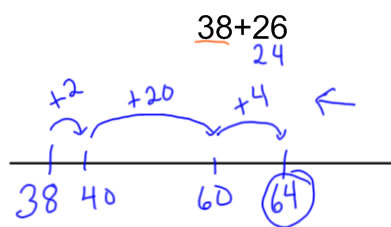
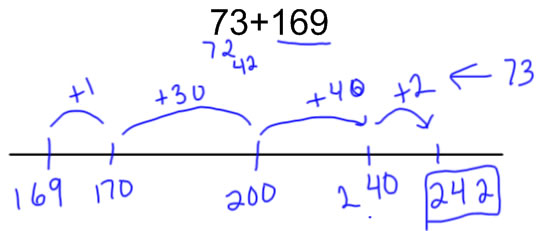
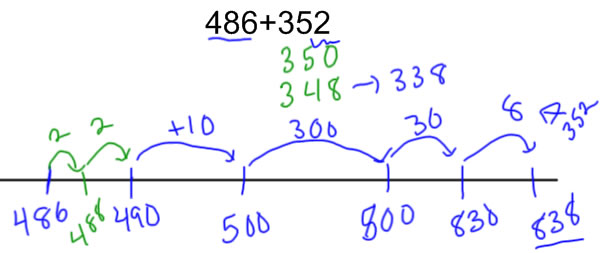
An algorithm is a set of steps that gets you to a result or an answer, so an addition algorithm is a set of steps that takes two numbers and finds the sum. This is similar to a computation strategy, but is a little more organized with the steps laid out clearly.
An alternate algorithm is one that is not the standard algorithm that is taught in most schools and textbooks.
This lesson includes 3 kinds of algorithms:
Student invented algorithms: these are algorithms that come from student invented strategies for computation. In this lesson we'll pick just 6 of these (3 for addition and 3 for subtraction) that we'll focus on and you'll be responsible for knowing.
Teaching/Scaffolding algorithms: these are algorithms that you might intentionally teach to prepare students to learn the standard algorithms. We'll look at three such algorithms:
Algorithms from other countries: these are algorithms you might encounter if the children in your class or their parents were educated in a different country. We'll look at just two of these:
Alternate algorithms fit into the Common Core State Standards for Mathematics as what appears to be the preferred way of teaching addition and subtraction in grades 1-3. Looking at the addition and subtraction in base 10 standards in grades 1-4, you'll see that the first time that the standard algorithm is required is in grade 4. Before grade 4, children are expected to solve addition and subtraction problems first using concrete models (eg. base 10 manipulatives) and later with place value strategies. The standard algorithm is an example of a place value strategy for adding and subtracting, but the standards imply that if the teacher can guide students to discover and invent appropriate strategies themselves, then that is preferred. There are two conditions that the standards put on algorithms that students should be using: that they use place value, and that the students understand how to record and explain the strategies they use.
|
The student invented algorithms discussed in this lesson will show you some of the things children may come up with, and examples for how to represent and record strategies in a way that children can use to show and explain their thinking. Additionally, the teaching/scaffolding algorithms are suggestions for algorithms that can be productively introduced to prepare students for learning the standard algorithm.
Adding on in chunks using multiples of 10 and 100 as bridge numbers
In this algorithm, we start by placing one of the addends (usually the larger one) on an open number line, and adding on by the other addend. This is similar to the counting on strategy where we start with one addend and count on by the other one. We aren't counting on one by one though, and we aren't adding on the whole addend at once, we are breaking down the second addend as we add it on. We're also looking for multiples of 10 (and later 100) on the number line to help us with breaking down the second addend.
Here are my three examples of writing this on the number line. I start with the larger addend on the number line (to the left). I draw arrows up the number line to get to a multiple of 10 or 100. On the arrow, I write how much I added, on the number line I write what the total is so far. I keep track of how much I still need to add by writing underneath the number I am adding on.



At the end, I check to make sure that all of the sums on the arrows add up to the number I am adding on. The sum is the final total on my number line.
Adding up to the minuend in chunks using multiples of 10 (and 100) as bridge numbers
This is a subtraction strategy that is similar to counting up to subtract and building up through 10 to subtract. In this algorithm, we start by putting both the subtrahend and the minuend on the number line (with the smaller subtrahend to the left, and the larger minuend to the right). We then figure out what we need to add on to the subtrahend to get to the minuend: this missing addend is the difference or the distance between the subtrahend and the minuend. We look for multiples of 10 and 100 to organize how we add in, and to make the adding on easier. The difference is the total amount that is added on to the get from the subtrahend up to the minuend.
Here are my three examples of writing this on the number line. I start by writing the subtrahend and the minuend on the number line. Then, starting with the subtrahend (on the left) I look for the next multiple of 10. I draw an arrow to the neares multiple of 10: on the number line, I write that number (multiple of 10) and on the arrow, I write how much to add to get to that amount. If I have a 2-digit problem, I next look for the multiple of 10 that's just less than the minuend, and I draw in the arrow to get me to that multiple of 10, and then the arrow to get to the minuend. If I have a 3-digit problem, I look for multiples of 100 to jump to that lies between the subtrahend and minuend.
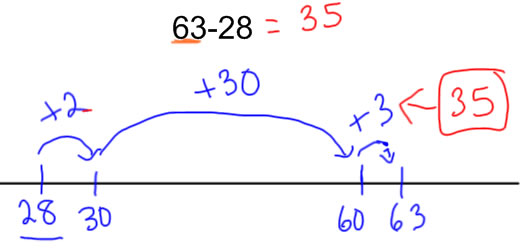
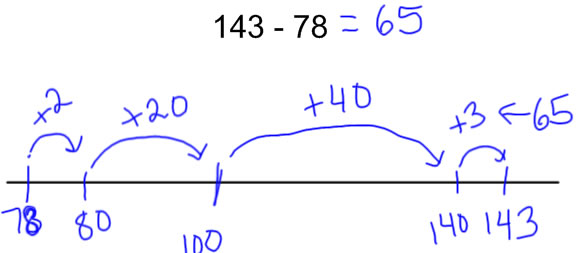

To get the final answer (the difference), I add up all of the numbers on the adding on arrows.
Add in place values and combine
Adding in place values is a really simple strategy, that is quite similar to the standard algorithm and is the same (except for how it's recorded) as the expanded algorithm for addition.
The numbers are separated into place values and each place value is added. Then the sums are added together two at a time. Children find different ways of recording this strategy. The one I'm going to show is a pretty simple, straightforward one such as a teacher might use in recording a child's oral description of how they added:
68 + 25 |
147 + 84 100+0=100 40+80=120 7+4=11 100+120=220 220+11=231 |
468 + 275 400+200=600 60+70=130 8+5=13 600+130=730 730+13=743 |
Subtract in place values using negative numbers, the negative numbers algorithm
This algorithm and strategy is common enough that it has a standardized name: the negative numbers algorithm. I'm also going to describe it as subtracting in place values using negative numbers.
In the addition algorithm where place values are handled separately, the only thing that needs to be adjusted at the end is to combine the partial sums by adding. In this algorithm, within each place value we're going to have to keep track of whether our result is a positive number (the amount that's left after subtracting) or a negative number (the amount that still needs to be subtracted later). Once each place value is computed, then the differences have to be put together, sometimes adding and sometimes subtracting.
Here are my examples. I subtract each place value separately, and then starting with the largest two, I combine them:
73 - 25 |
125 - 68 100-0=100 20 - 60 = -40 5 - 8 = -3 100 - 40 = 60 60 - 3 = 57 |
628 - 256 600 - 200 = 400 20 - 50 = -30 8 - 6 = 2 400 - 30 = 370 370 + 2 = 372 |
An advantage of the add in place values and subtract in place values strategies is that they stay pretty efficient as algorithms and strategies as you go up to 3 digit numbers from 2-digit numbers.
Add highest place values and compensate
This is a specific example of the general strategy of finding a nice friendly number that is close to the addends (perhaps by rounding) and then compensating at the end to find the final answer. This strategy really works best with 2-digit numbers, and you'll be primarily responsible for showing and explaining this strategy with 2-digit numbers.
In this strategy, you take just the highest place value from the numbers, and add them together. Then each of the other place values get added on one at a time. If you do this with 2-digit numbers, it makes a good strategy. If you do it with 3-digit numbers it gets very long and inefficient.
Here are my examples:
| 48 + 53 40 + 50 = 90 90 + 8 = 98 98 + 3 = 101 |
247 + 379 200 + 300 = 500 500 + 40 = 540 540 + 70 = 610 610 + 7 = 617 617 + 9 = 626 |
Subtract highest place values and compensate
This is a specific example of the general strategy of finding friendly numbers that are close to the subtrahend and minuend and then compensate at the end.
This strategy and algorithm works best with 2-digit numbers, and we're going to look just at the 2-digit number examples, but pay attention to how the compensation step is justified:
Here is an example
 |
First the tens values are subtracted: 80-20=60 is a good estimate for the difference. The 7 comes from the subtrahend, so it is part of the amount that should be taken away, so take away 7 from the estimate: 60-7=53 The 4 comes from the minuend, so it's part of the original amount to be taken from, so add 4 onto the estimate to find the final answer: 53 + 4 = 57 |
Shift the number line to subtract
This strategy is used to change a subtraction problem to be an easier problem that has the same answer. In this case, that usually means changing the problem so that the subtrahend is a multiple of 10. The difference in the subtraction problem stays the same when both the subtrahend and the minuend are shifted by the same amount:
| If you add 3 to 27, you get 30 (a multiple of 10). If you add 3 to 27 and you add 3 to 84, the difference (distance) between the two numbers stays the same, so you will get the same amount when you subtract. 84 - 27 = 87 - 30 = 57 |
Expanded Algorithm for Addition
The Expanded algorithm for addition is basically the same as the adding in place values and combining algorithm described above, but it is written vertically to make the connections to the standard algorithm more obvious.
The expanded algorithm differs from the standard algorithm in that it makes place value more obvious (the number in the tens place is more obviously a ten and not a one). By giving each place value a separate line, the values that would be "carried" in the standard algorithm are more clearly attached to the sums they came from.
Moving from the expanded algorithm to the standard algorithm requires being consistent about moving from right to left in working the problem, and it requires splitting the answers to the sums in each place value so that one digit is "carried" and added in with the next place value.
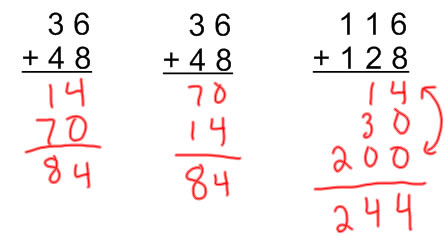
Break into place values (expanded subtraction)
This expanded subtraction algorithm follows exactly the same steps as the standard subtraction algorithm, but each place value is written out separately, which, among other things, makes it more obvious that when you trade a ten for 10 ones, those values are equal.
Moving from the expanded algorithm to the standard algorithm is mostly a matter of condensing the written form to show place value work with a single digit instead of with the full place value amount.
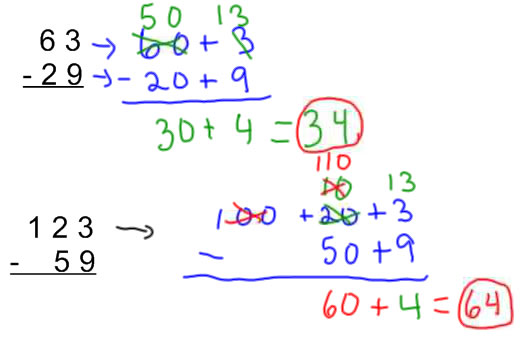
Trade First Subtraction
This subtraction method is a variation on the standard subtraction algorithm that may be easier for some children. In this algorithm, all of the trades in all of the place values are made before subtracting, rather than trading as needed as you go. In particular, the trading and subtraction can be correctly done left to right as well as right to left.

The British way of recording addition
This addition algorithm is the same as the US standard algorithm, but with the "carried" digits recorded down at the sum line rather than above the problem. There is no advantage to this when doing addition, but it turns out to simplify the multiplication algorithm somewhat, so I'm including it here.
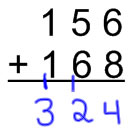
Equal Additions Algorithm
Unlike addition algorithms which are quite similar, there are at least 3 significantly different algorithms for subtraction, which are taught in different countries as being the "standard" algorithm. The algorithm that is standard in the US seems to be the most common one, and the second most common is the equal additions algorithm.
The equal additions algorithm works because when you add equally to the minuend and the subtrahend of a subtraction problem, the difference stays the same: 15 - 8=7 and if you add 2 to both 15 and 8, you get 17 - 10 = 7.
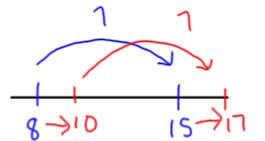
In this algorithm, in the place of trading or "borrowing" we add equally to the minuend and subtrahend. In this 2-digit example, we add 10 to the subtrahend in the tens place making 36 in place of 26. We equally add 10 to the minuend, but we add 10 to the ones place, so we have 60+14 in place of 64. This puts the problem in a form where we can subtract in the ones place and in the tens place.
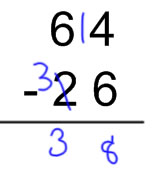
In these 3-digit examples, we add 10 equally to the tens place in the subtrahend and the ones place in the minuend. Then we add 100 equally to the hundreds place in the subtrahend and the tens place in the minuend.

This last example shows the one situation I'm aware of where the equal additions algorithm has an interesting advantage: when there is a 0 in the minuend, the US standard algorithm becomes more complicated at the trading step. However, because in this algorithm we add to the place values rather than taking away or breaking down, the 0 doesn't make anything more complicated.